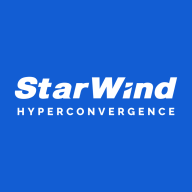

StarWind HyperConverged Appliance and Azure Stack HCI are key players in the hyper-convergence domain. While StarWind offers cost advantages and simplified management, Azure Stack HCI justifies its higher cost with superior feature integration, appealing to enterprises with hybrid needs.
Features: StarWind HyperConverged Appliance prioritizes cost-effective enterprise performance, flexibility without proprietary hardware, and scalability; its simplicity makes it a suitable option for small to medium businesses. Azure Stack HCI benefits from seamless integration with Microsoft’s ecosystem, robust security features, and support for Azure cloud services, which aligns well with businesses requiring hybrid cloud capabilities.
Room for Improvement: StarWind could enhance integration options with third-party ecosystems and improve its user interface for more intuitive navigation. Additionally, increasing documentation and expanding its advanced feature set would position it better against competitors. Azure Stack HCI deals with complex deployment, reliance on a Microsoft-centric approach, and a hefty initial investment; simplifying deployment and offering better support for non-Microsoft environments could alleviate these challenges.
Ease of Deployment and Customer Service: StarWind HyperConverged Appliance is known for its straightforward deployment process and hands-on customer service, often highlighted for its low complexity and efficiency. Azure Stack HCI, while benefitting from extensive documentation, has more complexity due to its deep integration with Microsoft services, receiving support from enterprise-grade customer service.
Pricing and ROI: StarWind is recognized for its competitive pricing structure, providing considerable ROI particularly for SMEs focusing on cost-efficiency and performance. Azure Stack HCI, though requiring a higher initial capital, aims for long-term value through integration benefits within the Microsoft ecosystem, attractive to enterprises positioning for future scalability and hybrid solutions.
There has been some return on investment in terms of just time usability and reduction of footprint.
Hyper V seems to lag behind compared to VMware.
The licensing is quite expensive because it's per call.
The integration with Azure using Azure Arc is excellent.


Azure Stack HCI efficiently integrates software-defined networking and Azure Kubernetes Service, offering a streamlined hybrid setup for VM management while maintaining top performance.
Azure Stack HCI enhances data center operations with high-end processors and storage, optimal Kubernetes support, and integration with Azure Arc and Azure Site Recovery. High application density in four-node configurations improves both time and infrastructure efficiency. Despite its strengths, the platform can improve in areas like software-defined networking, operational management, and simplifying deployments, which currently rely on PowerShell. Users often desire better training and integration with Microsoft Azure Portal, along with multi-cluster capabilities and storage architecture enhancements. Improvements in Hyper V virtualization are also needed to match competitors like VMware.
What are the key features of Azure Stack HCI?In sectors like government, Azure Stack HCI is crucial for running secure on-premise services with selectable Azure features to ensure data privacy. Businesses leverage the platform for VM creation, management, and monitoring through Windows Center, alongside Kubernetes production environments. Connectivity with Azure allows for smoother cloud transitions, appreciated for its dashboard manageability and substantial network capacity.
For SMB, ROBO and Enterprises, who look to bring in quick deployment and operation simplicity to virtualization workloads and reduce related expenses, our solution is StarWind HyperConverged Appliance (HCA). It unifies commodity servers, disks and flash, hypervisor of choice, StarWind Virtual SAN, Microsoft Storage Spaces Direct or VMware Virtual SAN and associated software into a single manageable layer. The HCA supports scale-up by adding disks and flash, and scale-out by adding extra nodes.
StarWind HyperConverged Appliance consists of StarWind Virtual SAN, Microsoft Storage Spaces Direct or VMware Virtual SAN “Ready Nodes”, targeting those, who are building their virtualization infrastructure from scratch. In case there is an existing set of servers, we offer a “software only version”, which is essentially our years proven StarWind Virtual SAN. Basically, it’s the fuel powering StarWind HCA.
We monitor all HCI reviews to prevent fraudulent reviews and keep review quality high. We do not post reviews by company employees or direct competitors. We validate each review for authenticity via cross-reference with LinkedIn, and personal follow-up with the reviewer when necessary.